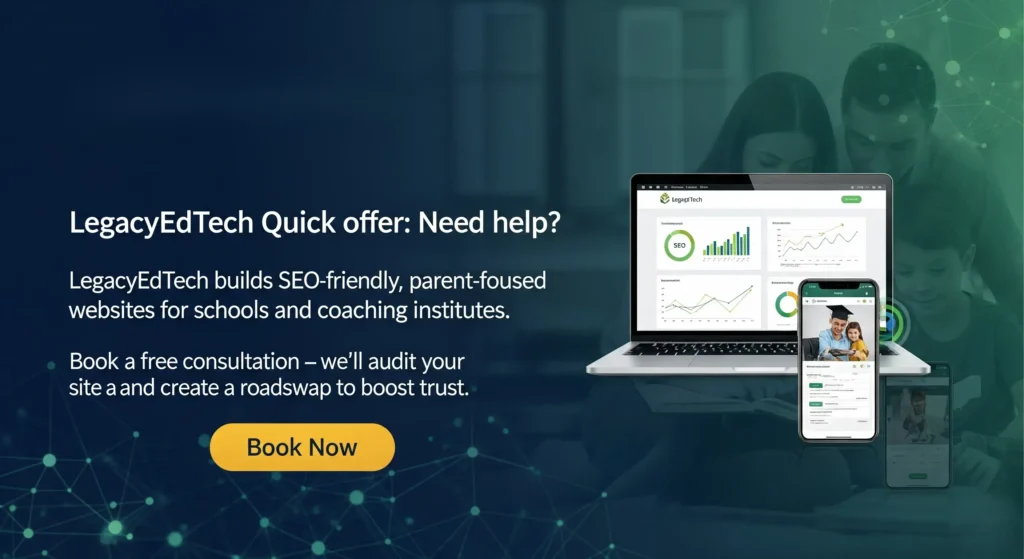Table of Contents
- Introduction
- What is hybrid learning in schools?
- Why parents prefer hybrid learning in schools — evidence and motives
- What modern parents expect — detailed list and how to deliver it
- Expectation 1 — Predictable, published schedules
- Expectation 2 — Tech that simply works
- Expectation 3 — Same learning outcomes regardless of location
- Expectation 4 — Transparent assessment and reporting
- Expectation 5 — Student wellbeing and social opportunities
- Expectation 6 — Clear policies and fair flexibility
- Expectation 7 — Parent orientation and quick training
- A practical 8-week pilot plan for hybrid learning in schools
- Cost considerations and ROI for schools
- Sample parent-facing communications
- Tools, roles and a simple tech stack
- Measuring success — KPIs and reporting cadence
- Examples & mini-case studies
- Common pitfalls and quick fixes
- Checklist: Ready-to-launch for hybrid learning in schools
- Frequently Asked Questions (FAQ)
- Conclusion
Introduction
Parents today are busy. They juggle careers, household logistics, and their child’s school life. They want learning that fits family life and still delivers academic progress. That’s why hybrid learning in schools has moved from a pandemic stopgap to an expectation for many families. The pain point is clear: parents want flexibility without losing quality or oversight. The solution is a well-designed hybrid program that combines proven pedagogy, reliable tech, and clear communication.
In this guide, you’ll find what modern parents expect from hybrid learning in schools, practical implementation steps, usable templates, and a checklist your leadership team can adopt this term. We’ll draw lessons from real pilots, research, and school practice to give you a hands-on roadmap.
What is hybrid learning in schools?
Hybrid learning in schools is an instructional model that combines face-to-face classroom time with online or remote learning. Students rotate between learning locations or participate simultaneously from different places. This model is distinct from purely blended or fully online learning because hybrid learning often involves synchronous instruction for both remote and in-person learners.
Core features:
- Classroom and virtual presence co-exist.
- Instruction is designed to be equitable for remote and in-person students.
- Technology (LMS, video conferencing, assessment tools) is central.
- Teacher planning intentionally bridges both modes.
Why clarity matters: When you label your model clearly (hybrid vs blended vs hyflex), parents understand expectations. Parents evaluating schools look for the specific phrase “hybrid learning in schools” on websites and brochures.
Why parents prefer hybrid learning in schools — evidence and motives
Modern parents choose hybrid models for a mix of practical and pedagogical reasons:
- Flexibility: Hybrid learning in schools allows families to manage health, travel, or work schedules without losing learning continuity.
- Safety & contingency: It provides a ready plan if health advisories or travel disruptions occur.
- Personalization: Families appreciate options to pace learning or combine tutoring at home with in-class support.
- Visibility & involvement: Digital platforms let parents see assignments, grades, and teacher feedback.
Research and recent surveys show a tangible preference for flexible schooling options. Families compare schools on their hybrid capabilities when making enrollment decisions.
What modern parents expect — detailed list and how to deliver it
Below is an expanded list of expectations and exact steps schools can take to meet them. Each item includes a one-line parent statement and school actions.
Expectation 1 — Predictable, published schedules
Parent says: “Tell me when my child must be onsite.”
School actions:
- Publish a term calendar marking in-person vs remote days.
- Share a weekly schedule with hourly blocks in the LMS.
- Provide a mobile-friendly version for quick checks.
Template (Weekly snapshot): Monday: In-person (8:30–2:30). Tuesday: Remote synchronous 9–12. Wednesday: In-person project day. Thursday: Remote asynchronous. Friday: In-person review.
Expectation 2 — Tech that simply works
Parent says: “I don’t want to troubleshoot during class.”
School actions:
- Standardize on one LMS for content and assessment.
- Equip classrooms with a reliable camera and mic.
- Maintain a parent helpdesk and a one-page tech checklist.
Expectation 3 — Same learning outcomes regardless of location
Parent says: “My child should learn the same whether they’re in class or at home.”
School actions:
- Align online and offline tasks to the same learning objectives.
- Use short formative checks weekly to compare cohorts.
- Offer small-group synchronous tutoring for students needing support.
Expectation 4 — Transparent assessment and reporting
Parent says: “Show me progress in real terms.”
School actions:
- Provide digital gradebooks updated weekly.
- Send brief video summaries after major units.
- Run parent-teacher micro-meetings each term.
Expectation 5 — Student wellbeing and social opportunities
Parent says: “School should support my child socially and emotionally.”
School actions:
- Integrate SEL check-ins into remote sessions.
- Keep regular in-person or virtual clubs and project groups.
- Share access to counselors and wellbeing resources.
Expectation 6 — Clear policies and fair flexibility
Parent says: “If we miss a day, what happens?”
School actions:
- Provide clear attendance and make-up work policies.
- Offer recorded lessons and flexible assignment windows.
- Design assessment windows to reduce last-minute pressure.
Expectation 7 — Parent orientation and quick training
Parent says: “Show me how to support my child.”
School actions:
- Run a 60-minute onboarding webinar each term.
- Maintain a short FAQ and help video library.
- Offer drop-in tech clinics at predictable times.

A practical 8-week pilot plan for hybrid learning in schools
If your school wants to trial hybrid learning in schools, follow this eight-week pilot.
Weeks 1–2: Planning
- Define objectives, pilot classes, and success metrics.
- Audit tech and schedule teacher training sessions.
Weeks 3–4: Setup & training
- Install AV kit in pilot classrooms.
- Run teacher training on hybrid pedagogy and tools.
- Launch parent onboarding materials.
Weeks 5–6: Launch pilot
- Run pilot classes. Collect weekly feedback via short surveys.
- Monitor tech issues and attendance patterns.
Weeks 7–8: Evaluate & iterate
- Analyze KPIs: assignment completion, assessment results, parent satisfaction.
- Adjust schedule, tech, or supports and prepare for wider rollout.
Pilot checklist (quick): tech audit, teacher training, parent onboarding, schedule publication, feedback loop, KPI dashboard.
Cost considerations and ROI for schools
Budgeting matters. Here’s a simple breakdown for medium-sized schools (500–1000 students):
- One-time costs: AV kits (camera, mic, stable tripod), LMS setup, teacher training workshops.
- Recurring costs: LMS licenses, internet bandwidth, helpdesk staffing.
Estimated first-year investment: varies widely, but a phased pilot approach keeps costs manageable. Measured benefits include higher parent retention, potential to enroll families who value flexibility, and improved crisis resilience.
Sample parent-facing communications
Use simple, parent-first language. Here’s a 45-word blurb schools can publish on their site:
Our hybrid learning in schools program blends in-person teaching with flexible online learning. Families keep school continuity during travel or short-term illness. We provide clear schedules, a parent dashboard, and weekly progress summaries so you always know how your child is doing.
Tools, roles and a simple tech stack
Checklist for a clean hybrid setup:
- LMS: Central hub for content and grading (Google Classroom / Microsoft Teams / Moodle).
- Live lessons: Zoom / Teams / YouTube Live (recorded).
- Assessment: LMS quizzes, forms, or integrated tools like Kahoot or Quizizz.
- Support: Parent helpdesk + knowledge base.
Roles:
- Hybrid Lead: Coordinates program and parent communications.
- Tech Coach: Handles AV and helpdesk queries.
- Teacher Mentor: Trains and supports instructional staff.
Measuring success — KPIs and reporting cadence
Track these KPIs monthly and publish a termly community report:
- Attendance (in-person and online).
- Assignment completion rates.
- Learning growth (pre/post unit assessments).
- Tech uptime and issue resolution time.
- Parent satisfaction (simple 3-question survey).
Provide dashboards to heads and short summary emails to families.
Examples & mini-case studies
Mini-case 1: Urban private school — Added hybrid days for traveling families and offered recorded sessions. Outcome: Enrollment stability improved and parent satisfaction rose.
Mini-case 2: Small rural school — Used hybrid learning in schools to reduce travel disruptions and enable guest specialists to teach remotely. Outcome: Greater curriculum breadth without added local hiring.
These examples show hybrid can fit many school types. The key is design and consistency.
Common pitfalls and quick fixes
- Pitfall: Choosing too many platforms.
- Fix: Consolidate to one LMS and one live platform.
- Pitfall: Overloading teachers with tech tools.
- Fix: Limit features and provide scripted lesson templates.
- Pitfall: Poor parent communication.
- Fix: Weekly digest emails and a clearly labeled parent portal.
Checklist: Ready-to-launch for hybrid learning in schools
- Leadership has a written hybrid policy.
- Pilot classes selected and tech kit installed.
- Parent onboarding materials created (videos + FAQ).
- Teachers have training and mentoring schedules.
- KPIs defined and dashboard set up.
- Feedback loop established for parents and students.
Frequently Asked Questions (FAQ)
Will hybrid learning in schools harm social skills?
No—if schools schedule regular in-person social activities and project-based group work. Hybrid can be designed to prioritize social interaction during on-campus days.
How often should my child attend in-person?
Parents and schools often choose a 2–3 days in-person model per week. The right mix depends on age, subject, and family needs.
How does assessment work in hybrid learning?
Assessments include a mix of online quizzes, projects, and in-class tasks. Rubrics must be transparent and shared with parents.
Do teachers need special skills?
Yes. Effective hybrid teaching requires lesson design that keeps remote students active. Micro-training and mentorship shorten the learning curve.
How can small schools manage costs?
Start small. Use free or low-cost LMS options, borrow devices, and focus investment on reliable AV for pilot classrooms.
Conclusion
Today’s parents expect flexibility, transparency, and consistent learning outcomes. Hybrid learning in schools meets these expectations when implemented with clear policy, reliable tech, trained teachers, and regular communication. It is a strategic investment: flexible schooling builds trust, increases resilience, and often improves family satisfaction.
If your school aims to build or improve hybrid learning in schools, begin with a focused pilot, involve parents from day one, and measure the right data. Legacy EdTech can help with audits, training, and implementation blueprints tailored to your context.
Want a guided audit and a 6-week implementation plan for your school’s hybrid program? Reach out to Legacy EdTech and let’s design hybrid learning in schools that parents trust and students thrive in.







